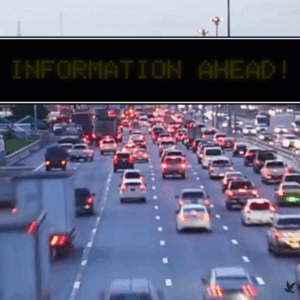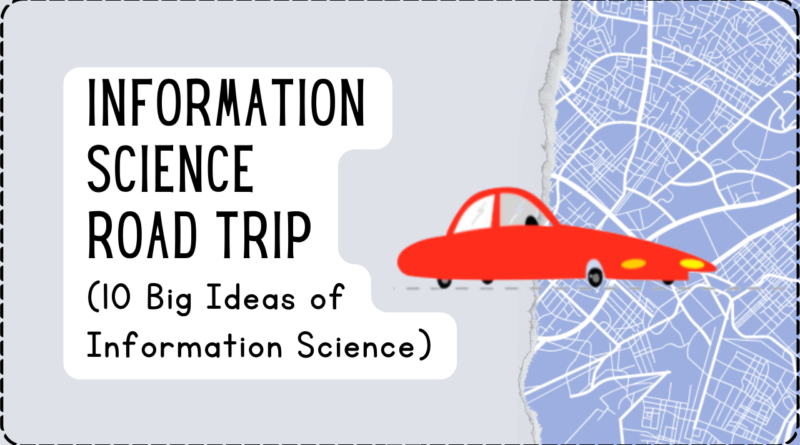Information Science Road Trip
Information Science Road Trip
Jenna Hartel
Are you in the mood for a multimedia Information Science adventure? If so, let’s go! I recently published the video Information Science Road Trip on my INFIDEOS YouTube channel. Metaphorically speaking, it takes sightseers on a panoramic journey through 10 “big ideas” of Information Science. The big ideas are visited at breakneck speed and the route is loosely chronological over the past century. The destinations are translated and simplified to deliver ah-ha! moments at every turn.
Educators, take note. This video is an ideal gateway for students beginning a course on Information Science. It could also help newcomers understand some of what an Information Science educational program, degree, or career entails. And if your efforts to explain Information Science to family and friends has felt less than successful, then try again with the help of this video. Within a few days of publication, Information Science Road Trip had hundreds of views and many likes. The American Society for Information Science and Technology featured it on their website, an endorsement that suggests the video succeeds in capturing some of the field’s spirit.

I made Information Science Road Trip to mitigate a shortage of accessible surveys of Information Science. After all, what resources present Information Science “in a nutshell”? There is the Wikipedia page on Information Science; the sprawling Topical Table of Contents of the Encyclopedia of Library and Information Sciences (Bates, 2010); celebrated statements by Borko (1968), Saracevic (1999) and Bates (1999), among others; browsing the chapters in the Annual Review of Information Science and Technology over the decades (Cuadra, 1966); and many bibliometric maps (White & McCaine, 1999; Milojevic, 2011). What may come closest to the video at hand is the paper “The Seventeen Theoretical Constructs of Information Searching and Information Retrieval” (Jansen & Rieh, 2010). But, mostly these comparable resources assume foreknowledge; reside behind university paywalls; and appear in print, not the video formats preferred by generations Y and Z. For the sake of due diligence, there are other YouTube videos about Information Science, such as What is INFORMATION SCIENCE? and Introduction to Information Science which viewers might contrast with Information Science Road Trip.

Before embarking, a fair question to ask is: By what criteria or rationale were the ten big ideas selected? Since there is no consensus on central concepts of Information Science, I relied upon my accumulated knowledge as a student, researcher and educator. Hence, Information Science Road Trip offers my opinion only. Nevertheless, all these ideas captured my imagination and fascinate students in my courses. Rather than fortifying any canon, I hope that putting this set forward will generate a public discussion about ideas that are defining and meritorious across Information Science.
Truth be told, the Road Trip was initially envisioned with 20 attractions. As production unfolded and content piled up, I felt that “less is more,” and with regret, cut the long list in half. Some notions parked for now were the Resnikof-Dolby Scale (Resnikoff & Dolby, 1971), Sense-Making (Dervin, 1983), and the Information Behavior and Information Practice Debate (Savolainen, 2007). Later, fellow Information Scientists who previewed the video lobbied to add bibliography and Boolean Search Logic to the conversation. All these big ideas (and any more that are contributed by viewers in the video’s comments field on YouTube) will be reconsidered for inclusion in a sequel video of 10 more big ideas of Information Science. (Further, concepts associate with the specialty of information behaviour will be featured in a narrower companion video, Information Behaviour Road Trip.) Stay tuned!

Though Information Science Road Trip is a survey and inherently historical, the conclusion is future-facing and asks: What big ideas are on the horizon of Information Science? There, at the edge of a mountain range, is indigenous ways of knowing, a complex term that defies a simple or universal definition. The video states, “Indigenous knowledges refer to the ways of teaching, learning, and knowing that exist across diverse indigenous communities. Such approaches may be social, generational, oral, spiritual, reciprocal, practical, and grounded in the earth.” Many of these informational dimensions are missing from the conventional landscape of Information Science as toured in the road trip. Yet they are clearly relevant, worthy, and even crucial to the future of the planet.
In the video’s reprisal, the 10 big ideas are presented as souvenirs. Information Science Road Trip has supplemental learning resources, too. The description field, located below the video, has links to source documents. For those who wish to learn more yet favor the video format, INFIDEOS has an Intellectual History of Information Science Playlist with nine videos on the theme. Finally, with educators and students in mind, there is a free and fun crossword puzzle that fortifies knowledge of the key concepts visited on the journey.
Now, fasten your seatbelt and click here to begin the Information Science Road Trip. Godspeed! (An expression of good wishes to a person starting a journey.)
References
Bates, M. J. (1999). The invisible substrate of information science. Journal of the American Society for Information Science, 50(12), 1043–1050.
Borko, H. (1968) Information science: What is it? Journal of the American Society for Information Science, 19, 3-5.
Cuadra, C. (1966). Annual review of information science and technology. Information Today.
Dervin, B. (1983). An overview of sense-making research: Concepts, methods and results. Paper presented at the annual meeting of the International Communication Association. Dallas, TX.
Jansen, & Rieh, S. Y. (2010). The seventeen theoretical constructs of information searching and information retrieval. Journal of the American Society for Information Science and Technology, 51(8), 1517–1534.
Milojević, S., Sugimoto, C.R., Yan, E., & Ding, Y. (2011). The cognitive structure of library and information science: Analysis of article title words. Journal of the American Society for Information Science and Technology, 62(10), 1933-1953.Hjorland Information Science History
Resnikoff, & Dolby, J. L. (1971). Access : a study of information storage and retrieval with emphasis on library information systems. U.S. Office of Education, Bureau of Research
Saracevic, T. (1999). Information science. Journal of the American Society for Information Science, 50(12), 1051–1063. Bates (Information Science)
Savolainen, R. (2007). Information behavior and information practice: Reviewing the “Umbrella Concepts” of information-seeking studies. The Library Quarterly, 77(2), 109–132.
White, & McCain, K. W. (1998). Visualizing a discipline: An author co-citation analysis of information science, 1972-1995. Journal of the American Society for Information Science, 49(4), 327–355.
Cite this article in APA as: Hartel, J. (2022, May 6). Information science road trip. Information Matters, Vol. 2, Issue 5. https://informationmatters.org/2022/05/information-science-road-trip/






